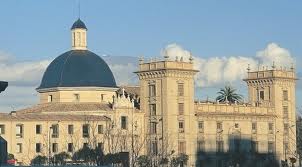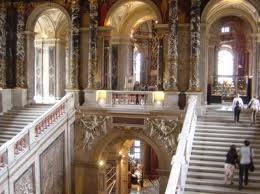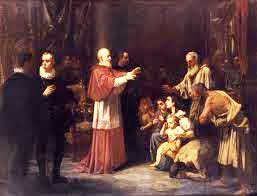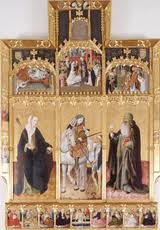Valencia Museum of Fine Arts

Where: Calle San Pío 9, 46010
Opening hours: Tuesday to Sunday from 10 am to 8 pm. Closed on Mondays, January 1, Good Friday and December 25
Special summer opening hours: Monday and Tuesday from 10 am to 5pm, Wednesday to Friday from 10 am to 8 pm, Saturday, Sunday and holidays from 10 am to 6 pm. Free admission.
The use of video and photographic camera is allowed in the permanent collection for personal use, however no tripod, flash or any kind of lighting device is allowed.
The Valencia Museum of Fine Arts is an important point of reference, especially in relation to Valencian Gothic art, as well as featuring other schools, and any Valencia city guide will recommend it.
The origin of the Valencia Museum of Fine Arts is related to the San Carlos Royal Academy of Fine Arts, whose statutes were approved by King Charles III in 1768. A small collection of artworks was gathered with donations by teachers and students, which would become the first real contribution of the future museum.
The final impulse for the creation of the gallery came after the seizure procedures from 1835-1837 which gave way to the creation of province museums of Fine Arts, whose initial collections were made of artworks confiscated from abolished convents and monasteries.

Through a royal decree dated from 1913, the Museum was officially detached from the San Carlos Royal Academy of Fine Arts, becoming an autonomous institution depending on the state and managed by patronage. During the Civil War, the museum was dismantled and used as artistic treasure storage. Its collection was transferred to Madrid and deposited in El Prado Museum.
Once the war was over, the museum's director began the appropriate negotiations to recover the paintings, and in 1939 he commissioned a study to value the damages suffered by the building during the conflict, in order to restore it. In the end, the decision was made to transfer the museum to the San Pío V Palace, built in the 18th century.
The building has two sections: the college and the temple, whose dome had to be reconstructed after being toppled in 1925. The building was used as a Charity Hospice between 1820 and 1826 and in 1835 it passed to the state, which first used it as an army supplies store, and as a military hospital during the Civil War. After the conflict, it housed the Valencia Museum of Fine Arts and to this day it remains the venue of the museum.
The Valencia Museum of Fine Arts Collection

The Valencia Museum of Fine Arts is the most important museum in the Community of Valencia. Since it was founded in 1837 till today, it has witnessed a large number of vicissitudes linked to the city's history. It is mainly formed by an inventory that consists of a large number of paintings, drawings and etchings as well as sculpture, archeological pieces, architectural fragments, decorative arts and photographs.
The museum also holds many temporary exhibitions, as well, so if you're studying Spanish in Valencia be sure to check what exhibitions are on before you visit.
The museum's most important sections are:
Gothic Painting from the 14th, 15th and 16th centuries. Possibly the most noted works in the museum are the Gothic panels by medieval artists known as 'primitive Valencians' (14th and 15th centuries), due to their quality and their complete artistic discourse. This extensive collection is comprised of complete panels of fragments painted with egg tempera almost exclusively technique, which would be used until the 15th century. Among international artists present in the collection we find Gherardo Starnina, with a panel that dates back to 1400. There are also examples of the Flemish school of painting which began using oils.
The mediaeval Valencian school of painting reaches maturity during the 15th century, and its artistry is comparable to the most beautiful and refined work produced in Europe.
Two styles developed from the 15th century onwards:

International Gothic: developed during the first half of the 15th century, fusing diverse trends in a a new style of undulated lines, with over-elaborate refinement and details. Artists such as Miquel Alcanyís, Gonçal Peris Sarrià and Pere Nicolau, among many others, are representatives of this style.
The Flemish style: developed from the second half of the 15th century onwards. It is less idealized and captures daily life, but it keeps certain conventionalism, such as the golden background. Jaume Baco, Jacomar and Joan Reixac painted in this style.
Another school of painting from Valencia with an important presence in the museum are the so-called proto-renaissance artists, whose paintings had defined characteristics and who blended Italian and Flemish elements. Among these we find Rodrigo de Osona, Sebastiano del Piombo, Nicolás Falcó, etc.
The Valencia Museum of Fine Arts features other sections:
- Renaissance: works by Joan de Joanes, Titian, El Greco, Pinturicchio (his only painting in Spain), Vicente Macip, etc.
- 17th and 18th century painting: works by Diego Velázquez (self portrait), Francisco de Goya, José de Ribera, Alonso Cano, Pieter van Lint, Murillo, Van Dyck, etc.
- 19th and 20th century painting: works by Benlliure, Federico Madrazo, Ignacio Zuloaga, Vicente López, Pinazo, Sorolla, etc.
- Works on paper: the museum's collection of drawings and etchings encompasses some 10,000 works of art, mostly exhibited in temporary exhibitions due to special storing conditions.
If you're planning to visit Spain, check out more activities that may interest you.



